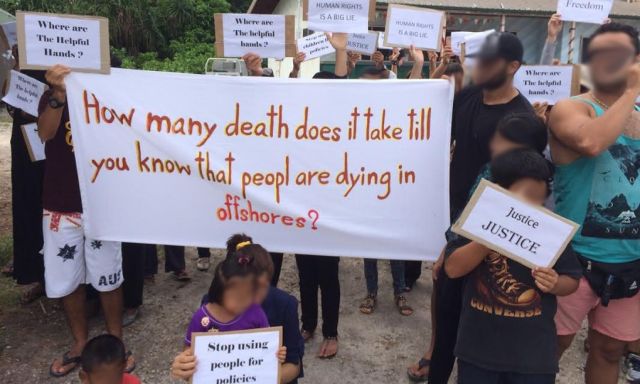
Eighty days on hunger strike has put an Iranian man who sought safety in Australia at death's door, as advocates around Australia fight for the immigration department to act to save his life.
“Martin” took the non-violent step to refuse to eat last November after the Australian government denied him refugee protection and redetained him in the remote Wickham Point Detention Centre. At least 15 other men in the same situation as Martin have also taken up a hunger strike.
He explained his protest in a YouTube video: “I fled Iran to be safe from torture and jail. But in Australia I have suffered even more. We have become like the walking dead, like a machine. We have become physically and mentally ill.
“I have lost my hope. It is too difficult to live.”
Martin ended his hunger strike on February 12, due to his case being listed for hearing in the local court. Supporters still hold fears about the possibility of irreparable physical damage and for his ongoing care.
Hunger strikes shorter than Martin's have proven fatal to conscientious protesters around the world in the past.
They are a common tactic used by refugees in Australia's detention centres. People stripped of all power, put in hopeless and interminable limbo, and suffering in filthy conditions will eventually risk their own body to escape such orchestrated torture.
It is only one way Australia's refugee policy is killing people, however.
1) DETENTION DEATH TRAPS
Conditions in the Manus Island detention centre have already proven fatal twice. February 17 marks one year since 23-year-old Reza Berati was violently killed when protests were met with attacks from guards and locals.
It has been just six months since neglected and overloaded medical services led to the death of 24-year-old Hamid Kehazaei last September. He contracted septicemia from an untreated cut on his foot.
On Nauru, doctors and nurses penned a letter detailing the inevitable mental toll on people in the camps: "Asylum seekers are already prone to mental health problems from the traumas they have suffered at home and in flight. It is chilling to think we may be deliberately increasing the risk that fellow human beings will have long-term mental health problems.”
A Human Rights Commission report, The Forgotten Children condemned the Nauru camp, saying it had “profoundly negative impacts” on children. This has been well-known for some time, but the report details just how bad Nauru has become in the past year.
The Guardian said the report found: “More than 300 children committed or threatened self-harm in a 15-month period in Australian immigration detention, 30 reported sexual assault, nearly 30 went on hunger strike and more than 200 were involved in assaults.”
Yet PM TonyAbbott merely labelled the shocking report “partisan” and is content to leave the deplorable conditions until further tragedy inevitably ensues.
2) DEPORTING TO DEATH
While Australia is deporting growing numbers of asylum seekers back to well-documented human rights abusers, advocates in Australia have desperately tried to keep track of them.
In Afghanistan, asylum seekers deported from Western countries are actually bigger targets to the Taliban, but the Australian government signed a deal with the Afghan government allowing forced returns.
Hazaras deported from Australia have been abducted, tortured and — in some cases — murdered by the Taliban soon after returning.
A similar deal exists with Sri Lanka, where Tamils are systematically persecuted by the government.
Refugee Council of Australia president Phil Glendenning said that between October 2013 and June 2014, up to 1200 people, mostly Tamils, have been forcibly deported to Sri Lanka. He said at the time: “Some of those people remain in prison in Negombo in seven by 10 metre spaces with 75 others …
“In previous years, at least nine asylum seekers who were returned were killed.”
3) DESPAIR IN THE COMMUNITY
Refugees have also died on Australian soil out of fear of deportation and the intentionally protracted refugee application process.
A 30-year-old Eritrean man, Rezene Mebrahta Engeda, drowned himself in Victoria's Maribyrnong River in February last year after receiving a letter stating that his refugee application had been refused.
And no one should forget 29-year-old Tamil man Leo Seemanpillai, who died of his injuries after self-immolating on May 31 last year. Deportation was a constant fear Seemanpillai lived with.
His eulogy evoked the responsibility of the government in his death: "Our government is proactively brutal and intentionally determined to break the spirits of people like Leo, who once imagined they would find protection from oppression in our care.”
For tens of thousands of refugees in the community, almost no services – which have been progressively starved of funding – means enforced poverty for many.
4) DESPERATION ON HIGH SEAS AND INDONESIA
Many critics of the previous Labor government’s refugee policy blamed Australia's inability to “stop the boats” for several tragic deaths at sea, because they were on rickety boats that capsized on the journey.
Yet Abbott and former immigration minister Scott Morrison's “Operation Sovereign Borders” has led to suicidal stand-offs between the Australian navy and asylum seekers, abuse allegations, and innocent refugees being thrown into brutal Indonesian jails.
For refugees now stuck in Indonesia due to Morrison's decision to ignore all protection applications from July 1 last year, life on the streets and dodging immigration police is their only option.
Australia's anti-refugee policy is rooted in creating hostile conditions, deliberate neglect and forcing the crisis of population displacement onto Third World countries. That tragic deaths arise from this system is not surprising, but it should still invoke outrage and action from Australians.
Like the article? Subscribe to Green Left now! You can also like us on Facebook and follow us on Twitter.